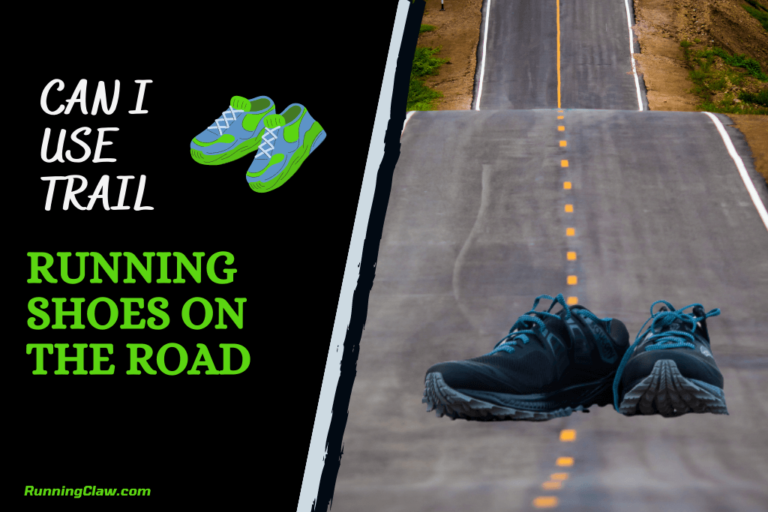Yes, it is OK to use trail running shoes on the road. But there are many aspects you should consider. Well, If you are a runner and run on different surfaces, your presence here proves you want to learn about trail running shoes should be used or not on the road.
Let’s know about this in a deep down way. Every surface requires a specific kind of grip provided by specific shoes. But having different pairs of shoes could be expensive.
I will guide you to use Trail Running Shoes on the Road and the difference between Road and Trail Running Shoes.
So, stick to this article; I am sure it will be worth reading.
Road vs. Trail Running Shoes
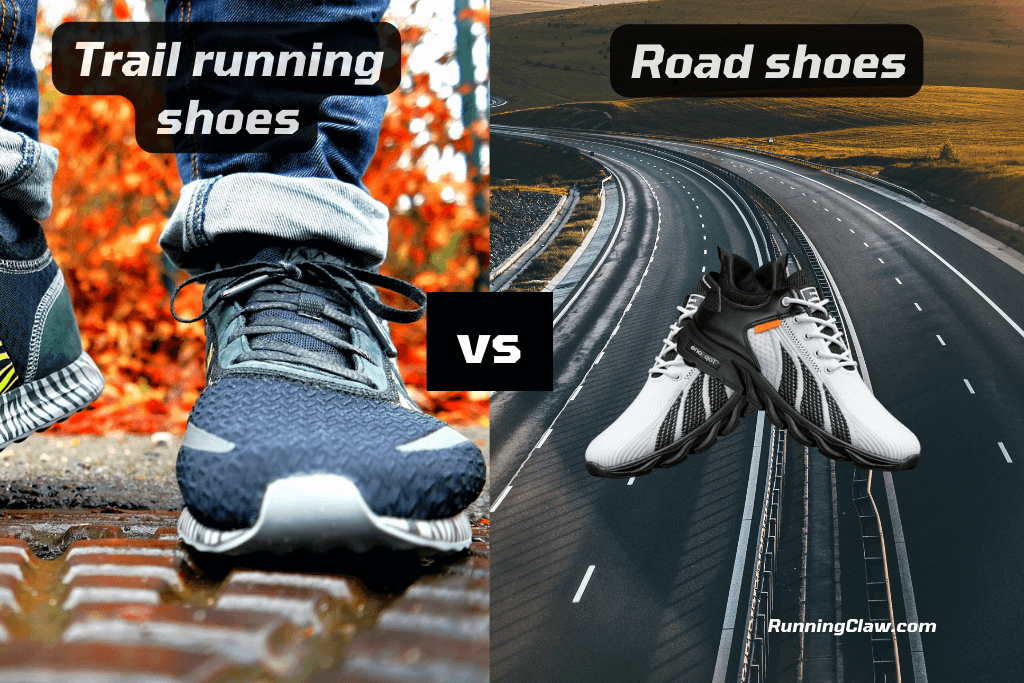
First, here is the comparison between Road and Trail Running Shoes.
Soles:
Sole is the basic difference between Road and Trail Running Shoes. Trail shoes are specifically engineered with soles with superior traction capabilities, enabling them to effectively grip and navigate uneven surfaces commonly encountered on trails.
Enhanced traction can be achieved using larger lugs, teeth, and a stickier rubber compound. This combination improves performance when traversing various terrains such as dirt, mud, and rocks.
Additionally, many footwear options feature a rock plate composed of durable plastic material strategically positioned within the mid-sole region. This rock plate safeguards the foot against potential hazards such as rocks and sharp sticks.
Road shoes are primarily engineered to optimize flexibility and enhance speed. Consequently, these shoes are frequently designed with reduced weight, facilitating swift and efficient propulsion on even surfaces.
Read | Running Shoes Vs Sneakers
Uppers:
Typically, running shoes are equipped with uppers, which refer to the shoe section positioned above the midsole. These uppers are constructed using breathable materials, facilitating adequate ventilation to keep the feet cool while running.
In contrast, trail shoes typically feature uppers constructed from thicker materials. The presence of a tightly woven mesh on a trail shoe serves the purpose of mitigating the risk of rips caused by trail debris.
Weight:
Another difference is the Weight of the Shoe. Weight is the most essential element if you are running.
Trail shoes typically exhibit a higher weight profile in comparison to road shoes. In the trail shoe category, various weights are offered. Light trail shoes offer enhanced stability and assistance for traversing meticulously maintained trails.
Rugged trail shoes are designed to protect your feet across various terrain. Off-trail shoes offer superior protection and support for running on rugged or challenging terrain.
Stability:
You run well when stable, and good shoes provide this stability. Both trail shoes and road shoes are equipped with stability features.
Most trail shoes are equipped with stability features that aid in minimizing the risk of ankle injuries when traversing uneven terrains. The support materials are commonly positioned along the sides and underneath the foot.
Road shoes typically offer fewer stability features for running on unstable surfaces, as their primary design focuses on optimal performance on even surfaces.
However, one can discover stability features that enhance appropriate foot alignment and running form.
Water Proof:
A significant distinction exists between trail running shoes and Road running shoes concerning their waterproofing capabilities. Trail running shoes are specifically engineered to endure various weather conditions and terrains, necessitating comprehensive waterproofing throughout the shoe.
In contrast, Road running shoes necessitate waterproofing solely in regions highly susceptible to water exposure, specifically the toe box and the heel.
This is because road runners generally abstain from running in wet weather conditions. Moreover, even if they engage in such activities, they are unlikely to encounter comparable mud, puddles, and other impediments commonly faced by trail runners.
Trail running shoes are typically characterized by their increased weight and higher price point than road running shoes. If one is seeking footwear capable of withstanding diverse environmental conditions, a suitable choice would be a pair of trail runners.
If the primary concern is maintaining dryness during light rainfall or on wet surfaces, road running shoes are a suitable choice.
When to wear Trail Running Shoes?

Now I will guide you about when to wear trail running shoes. Trail running has several advantages, but you must wear the proper footwear.
Typically, rocky, muddy, and uneven ground call for trail shoes. Thanks to the durable design, your ankles will be kept stable, your feet will be safeguarded, and your body will be kept secure from falls on trails. However, there are situations when walking on concrete with trail shoes makes sense.
For instance, you might discover that jogging in the rain or snow is safer when you use trail running shoes on the Road. When walking on slick surfaces, traction can be very useful.
Trail shoes are frequently more water-resistant and will probably keep your feet drier. These shoes might be more comfortable in uncomfortable circumstances.
Even waterproof versions are available; these are sometimes marked with the letters GTX (for Gore-tex).
When to wear Road Shoes?
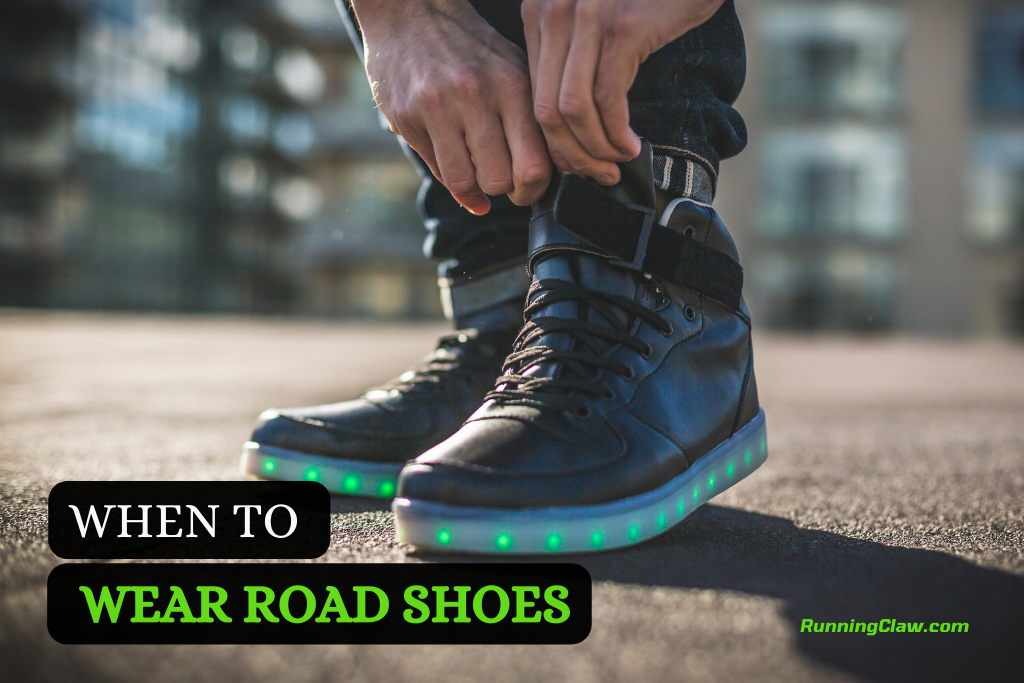
By reading this paragraph, you will know when it is suitable to wear Road Shoes. While it is true that modern rounds of trail running shoes exhibit reduced weight and enhanced flexibility, there exist specific scenarios wherein a specialized road shoe is preferable.
Utilizing a trail running shoe is not advisable for road running activities involving higher-intensity workouts, such as tempo runs or interval workouts.
Individuals will probably experience enhanced comfort and increased speed when utilizing a road shoe with a lighter weight.
In high temperatures and humidity, individuals may opt for Road running shoes instead of trail running shoes to mitigate excessive perspiration and maintain foot dryness.
Finally, it is imperative to utilize a specialized shoe for tracking workouts. Certain individuals participating in running activities may utilize a road shoe during track workouts.
However, it is worth noting that track shoes, which may or may not be equipped with spikes, are also a viable alternative.
It is advisable to refrain from utilizing lightweight road shoes when traversing highly uneven or treacherous terrain characterized by an abundance of rocks or a propensity for slipperiness. Insufficient traction may result in an increased likelihood of slips and falls.
Can I Use Trail Running Shoes on the Road?
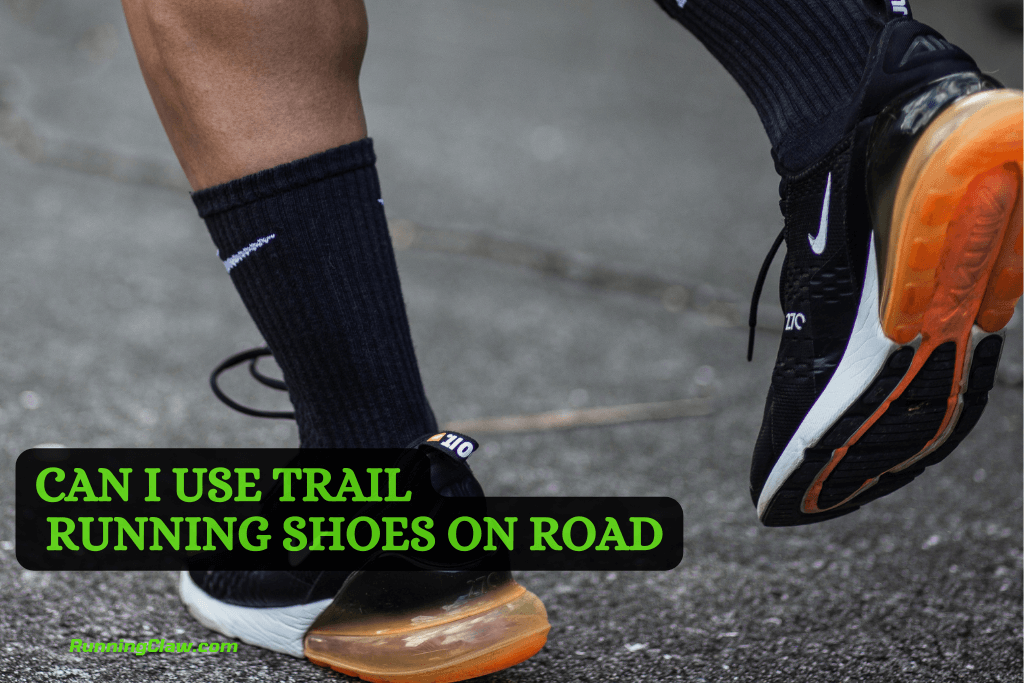
Trail runners can be utilized on road surfaces, although they may not be optimal for extended distances on solid terrains.
Trail runners have been specifically engineered to prioritize stability and traction, resulting in a slightly higher weight than conventional running shoes. Extended periods of wear may cause discomfort for the wearer.
Disadvantages of Wearing Trail Running Shoes on the Road:
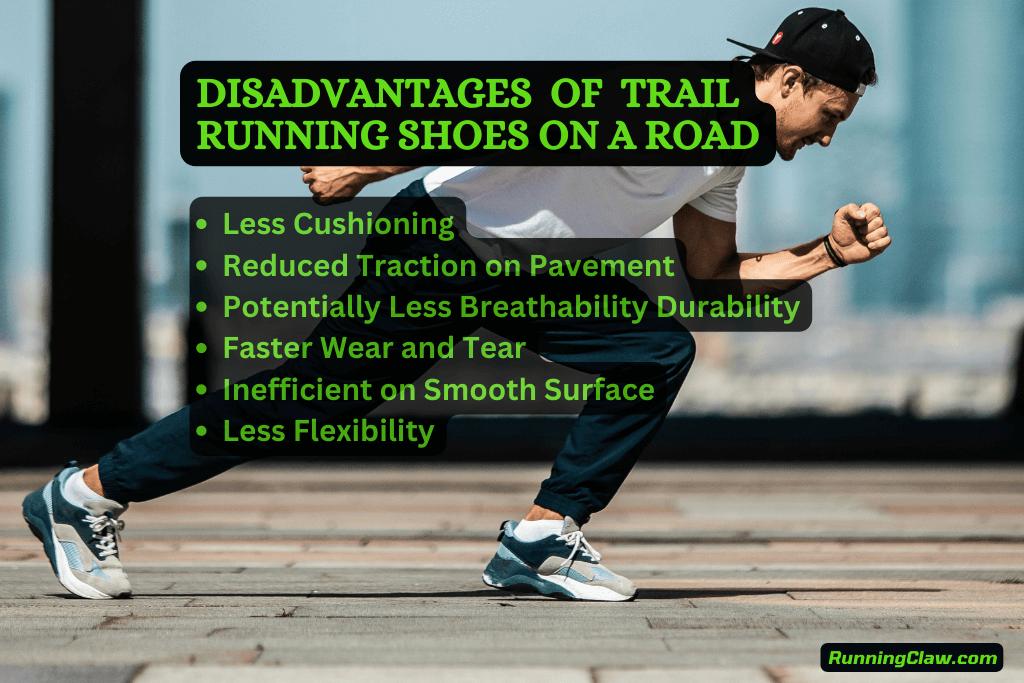
Trail running shoes are specifically engineered to excel in off-road environments and endure demanding conditions.
However, it is worth noting that they are also suitable for Road running. Nevertheless, it is imperative to acknowledge that they may have certain drawbacks compared to conventional road running shoes.
The following are a few drawbacks associated with utilizing trail running shoes for Road running:
Less Cushioning:
Trail running shoes are designed with a firmer and more aggressive sole to offer enhanced stability and protection when traversing uneven terrain.
The present design may not provide equivalent cushioning as road running shoes, specifically engineered to effectively absorb impact on solid surfaces such as asphalt and concrete.
This may result in diminished comfort during running activities and potentially elevate the likelihood of sustaining impact-related injuries, particularly when engaging in extended road running sessions.
Reduced Traction on Pavement:
Trail running shoes are frequently equipped with highly aggressive lugs and an outsole specifically engineered to optimize traction on unstable or muddy terrains.
When driving, these lug patterns may not offer the most efficient traction, and the additional grip may result in excessive friction, potentially causing premature deterioration of the outsole.
Potentially Less Breathability:
Certain trail running shoes have been specifically engineered to enhance the foot’s protection against moisture and debris encountered during trail running activities.
Consequently, these shoes may exhibit a slightly diminished breathability compared to their road-running counterparts. In the presence of elevated pavement temperatures, this may result in feelings of discomfort and increased production of sweat.
Faster Wear and Tear:
The utilization of trail running shoes on pavement surfaces may result in accelerated wear and tear. The shoes’ durability may be compromised due to the accelerated wear and tear of the aggressive lugs when used on the Road, which is a harder surface than trail conditions. As a result, the overall lifespan of the shoes may be reduced.
Inefficient on Smooth Surfaces:
Trail running shoes are specifically engineered to maximize performance and enhance the ability to traverse challenging and uneven terrains not typically found on traditional running surfaces.
When employed on uniformly smooth surfaces such as roads, the specialized attributes that augment performance on trails may exhibit diminished utility, resulting in suboptimal performance and reduced energy efficiency.
Heavier Weight:
Trail running shoes are frequently designed with enhanced durability, utilizing robust materials to endure challenging terrains effectively. Consequently, this construction typically weighs more than road running shoes.
The potential impact of increased weight may not be readily discernible during brief trail runs; however, it can manifest as a drawback when traversing on paved surfaces. In such instances, a shoe with a lighter build has the potential to enhance running efficacy and mitigate the onset of fatigue.
Less Flexibility:
Trail running shoes are designed with stiffer soles to offer enhanced stability and safeguard the foot against the potential hazards of uneven terrain.
This helps on bumpy ground but might make running on flat surfaces feel a bit off, possibly affecting how you run and your overall sports performance
Although trail running shoes can serve as a temporary solution for Road running, they are not the optimal choice for regular road training.
Individuals who predominantly engage in running activities on paved surfaces should consider acquiring a pair of Road running shoes with superior cushioning, reduced weight, and enhanced flexibility. This prudent choice will contribute to heightened comfort and efficiency during running sessions.
Conclusion:
It is OK to wear Trail Running Shoes on Road, but still, there are many aspects that you should consider before choosing Trail Running Shoes on Road. Because ultimately, there are chances of injuries due to the heavy weight of Trail Runners.
So, Choose Wisely!
Related Posts:
- Can I Use Running Shoes for Walking
- Running Shoes Vs Sneakers
- Can I Use Running Shoes for Trekking
- Can I Use Trail Running Shoes on A Treadmill
- Can I Use Running Shoes for Biking
- Can I Wear Running Shoes for Dance
- Can I Use Running Shoes for Volleyball
- Can I Use Running Shoes for Lifting
- Can I Use Running Shoes for Cross Training
- Can I Use Running Shoes for Soccer
- Can I Use Running Shoes for Badminton
- Can I Use Running Shoes for Jump Rope
- Can I Use Running Shoes for Sports
- Fullback in Soccer – What to do as a Fullback


